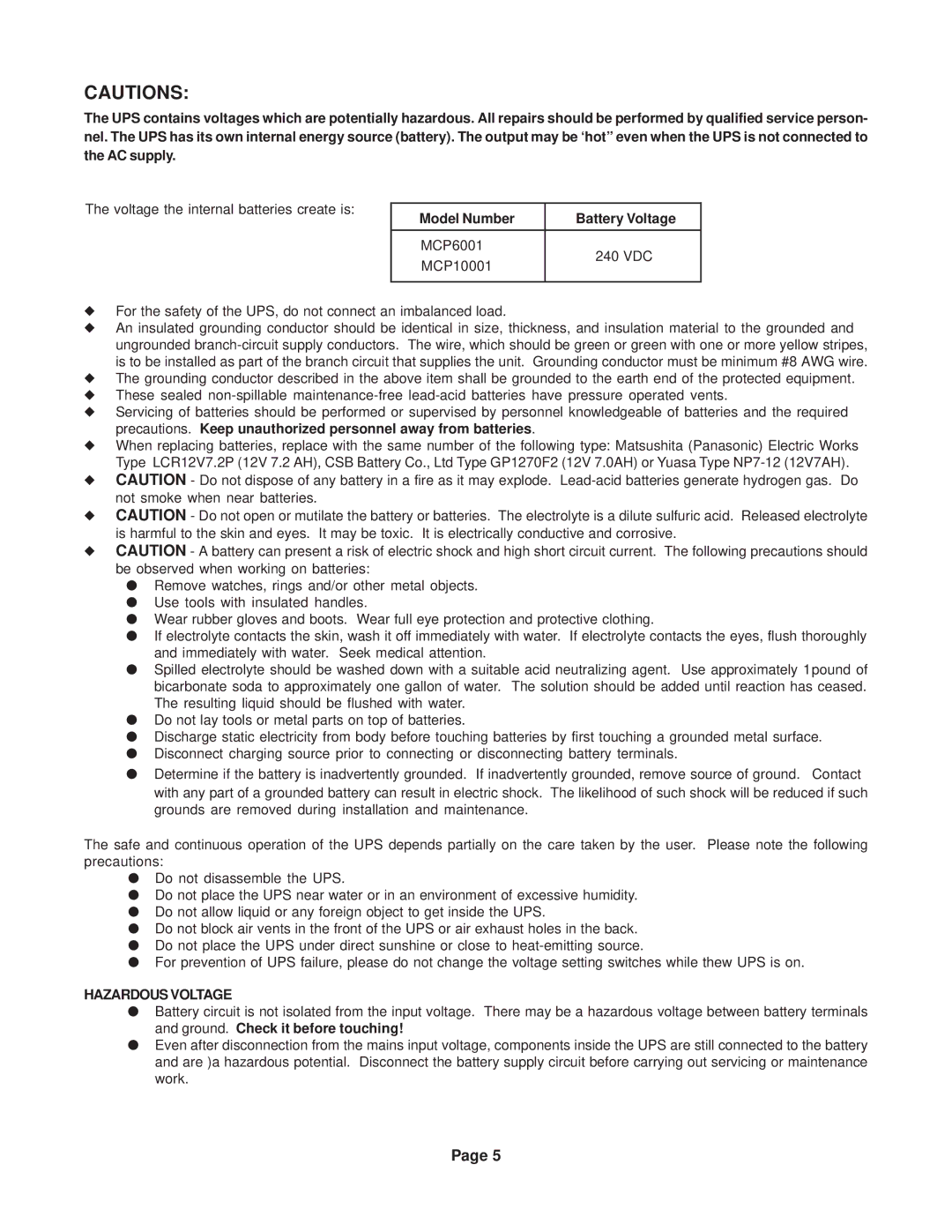CAUTIONS:
The UPS contains voltages which are potentially hazardous. All repairs should be performed by qualified service person- nel. The UPS has its own internal energy source (battery). The output may be ‘hot” even when the UPS is not connected to the AC supply.
The voltage the internal batteries create is:
Model Number | Battery Voltage | |
MCP6001 | 240 VDC | |
MCP10001 | ||
| ||
|
|
◆For the safety of the UPS, do not connect an imbalanced load.
◆An insulated grounding conductor should be identical in size, thickness, and insulation material to the grounded and ungrounded
◆The grounding conductor described in the above item shall be grounded to the earth end of the protected equipment.
◆These sealed
◆Servicing of batteries should be performed or supervised by personnel knowledgeable of batteries and the required precautions. Keep unauthorized personnel away from batteries.
◆When replacing batteries, replace with the same number of the following type: Matsushita (Panasonic) Electric Works Type LCR12V7.2P (12V 7.2 AH), CSB Battery Co., Ltd Type GP1270F2 (12V 7.0AH) or Yuasa Type
◆CAUTION - Do not dispose of any battery in a fire as it may explode.
◆CAUTION - Do not open or mutilate the battery or batteries. The electrolyte is a dilute sulfuric acid. Released electrolyte is harmful to the skin and eyes. It may be toxic. It is electrically conductive and corrosive.
◆CAUTION - A battery can present a risk of electric shock and high short circuit current. The following precautions should be observed when working on batteries:
●Remove watches, rings and/or other metal objects.
●Use tools with insulated handles.
●Wear rubber gloves and boots. Wear full eye protection and protective clothing.
●If electrolyte contacts the skin, wash it off immediately with water. If electrolyte contacts the eyes, flush thoroughly and immediately with water. Seek medical attention.
●Spilled electrolyte should be washed down with a suitable acid neutralizing agent. Use approximately 1pound of bicarbonate soda to approximately one gallon of water. The solution should be added until reaction has ceased. The resulting liquid should be flushed with water.
●Do not lay tools or metal parts on top of batteries.
●Discharge static electricity from body before touching batteries by first touching a grounded metal surface.
●Disconnect charging source prior to connecting or disconnecting battery terminals.
●Determine if the battery is inadvertently grounded. If inadvertently grounded, remove source of ground. Contact with any part of a grounded battery can result in electric shock. The likelihood of such shock will be reduced if such grounds are removed during installation and maintenance.
The safe and continuous operation of the UPS depends partially on the care taken by the user. Please note the following precautions:
●Do not disassemble the UPS.
●Do not place the UPS near water or in an environment of excessive humidity.
●Do not allow liquid or any foreign object to get inside the UPS.
●Do not block air vents in the front of the UPS or air exhaust holes in the back.
●Do not place the UPS under direct sunshine or close to
●For prevention of UPS failure, please do not change the voltage setting switches while thew UPS is on.
HAZARDOUS VOLTAGE
●Battery circuit is not isolated from the input voltage. There may be a hazardous voltage between battery terminals and ground. Check it before touching!
●Even after disconnection from the mains input voltage, components inside the UPS are still connected to the battery and are )a hazardous potential. Disconnect the battery supply circuit before carrying out servicing or maintenance work.
Page 5
